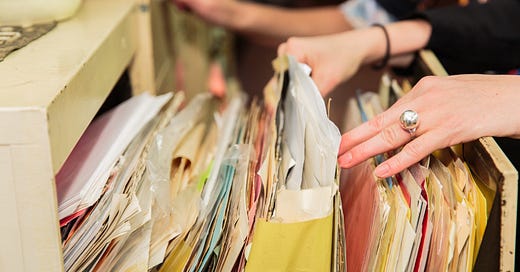When most people think of an archive, they think of rows of dusty boxes in governmental buildings, usually holding municipal records. It’s something that’s inaccessible to the public. Our Adopt a Box campaign aims to change that train of thought by making the archival process more communal, accessible, and most importantly, equitable.
Archival Multiverse
I want to introduce, you, our readers, to the archival multiverse1. The archival multiverse describes the change in archival practice that has come as a result of the boom of community and cultural archives. These new kinds of archives allowed marginalized communities to take control of their own narratives and developed new ways of collecting, preserving and telling their histories to the public.
So, within the archival multiverse, how do feminist archives function? What makes an archive feminist? Mostly, it’s about praxis. It’s about how record creators are treated, how materials are described and what kinds of histories are prioritized within larger collections. Our mission is rooted in the work of Drs. Michelle Caswell and Marika Cifor as we shape our partnerships within a feminist ethics of care. This means we shape our relationships in a framework of radical empathy and mutual responsibility.
Digitization + Feminist Ethics of Care
How might this look in our work of digitizing collections? Though digitization may seem straightforward— i.e going through boxes of materials, curating a selection to digitize, creating identifiers, and then rehoming the materials in acid-free archival folders, it’s much more relationship based than that.
Kolin Mendez. TFI Staff in Mary Beth Edelson’s Studio. 2018.
Where TFI is often working with independent record-holders’ personal collections, the digitization process is an affective landscape. Certain materials may bring up memories, emotions etc., and to stay true to our feminist ethics of care, it’s important for the TFI staff to prioritize collaboration with the record-holders and honor their wishes in how the collection is presented once analog materials are digitized.
Put simply, the process is more important than the end product. This doesn’t mean the quality of the collection suffers. In fact, generally, the metadata and descriptions of materials benefit from working so closely with the record creators as you learn more tidbits and nuances of the collection and history itself.
We at TFI are proud to walk in the footsteps of feminist archivists who have developed these practices and challenged traditional productions of history. To us, it’s part of information activism— not only uncovering and making available hidden narratives but building strong relationships within our community while we do it. If this kind of work inspires you, we humbly ask that you consider donating to our Adopt-a-box campaign and sharing it with a friend.
See Popple, Mutibwa, and Prescott’s (2020), Community archives and the creation of living knowledge, to learn more about the archival multiverse.






The archival multiverse and community archiving are definitely important, as is giving more communities control over their records. And I'll surely include this in my newsletter, especially since I read some works by Michelle Caswell while in library school, and took a class with Ricky Punzalan (he's no longer there, but is at another university now) on archival appraisal.
However, I take issue with the statement at the beginning of this post: "When most people think of an archive, they think of rows of dusty boxes in governmental buildings, usually holding municipal records. It’s something that’s inaccessible to the public." While this description is correct, it is important to remember that these beliefs about archives are caused by cultural depictions of archives (and archivists), which show archives as dusty places within basements or with cobwebs. Furthermore, those beliefs are not rooted in reality. In terms of records being inaccessible, I'd say it depends on what is being accessed, whether it is classified (that's what I index for my job), falling apart, etc. It makes sense, in those settings, for an archivist to be pulling records for a researcher in response to a slip you fill out in-person or online, rather than researchers going inside the stacks themselves, as that could raise liability or security concerns about the records.
Furthermore, the code of ethics (and core values) of the profession, as stated by the SAA, say that accessibility is one of the guiding principles of archives. If the archives (or archivists) aren't assisting their patrons, then surely they are violating those principles. Of course, there is nothing bounding archives from following these principles, and the principles themselves have their limitations and exclusions, as they are mainly tailored toward institutional archives.
In sum, I wish there was more context in this post about this, as there have been efforts, from what I've read, within institutional archives to make "the archival process more communal, accessible, and most importantly, equitable", although not the same way as this post notes. Even so, more work, obviously, needs to be done, as most records still reside within institutional archives, and it seems like NARA has made some strides in that direction. And, community archives surely provide a different model which can buck the usual (and typical?) and institutional model of archives, possibly even pushing institutional archives to change for the better.
Otherwise, the description of digitization and how it connects feminist ethics of care was interesting, reminding me a bit of what I read about in graduate school. So, I'd love to read more about that. I do think that having a good end product from digitization is important, though, as I've seen some institutional archives digitize documents, but either the copy is bad or the file takes so long to load that it is inaccessible. In the end, I'm glad I read this post, and am interested on learning more about this project.